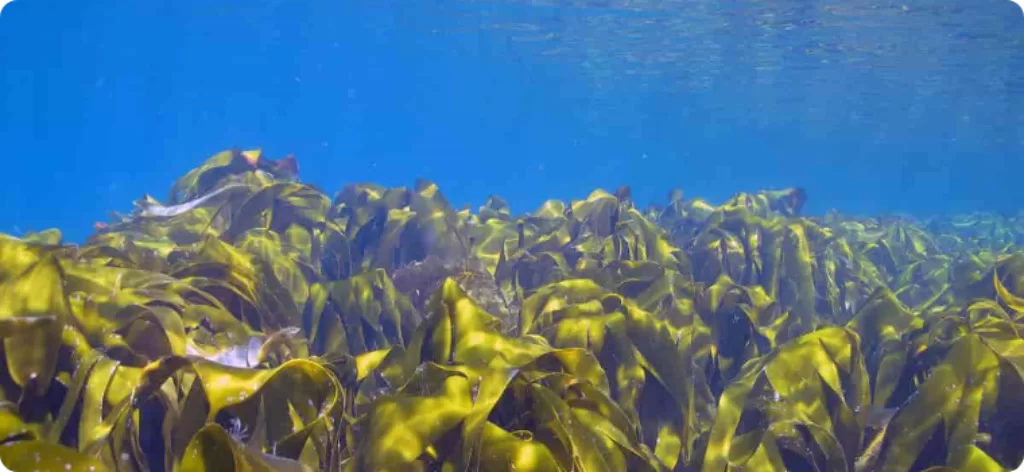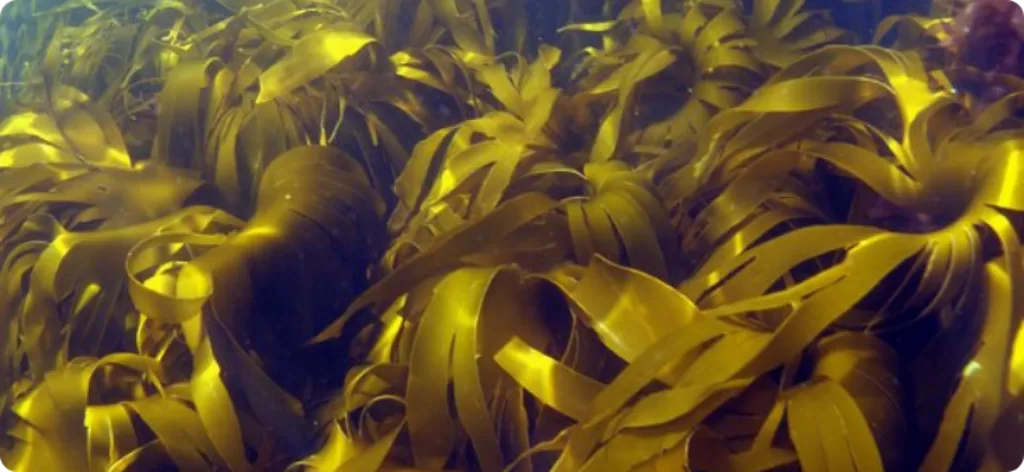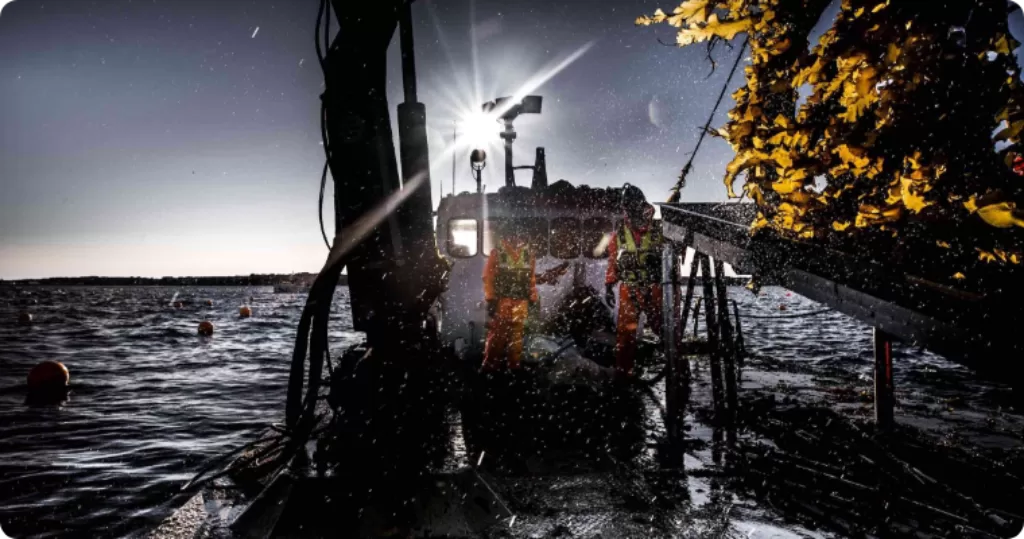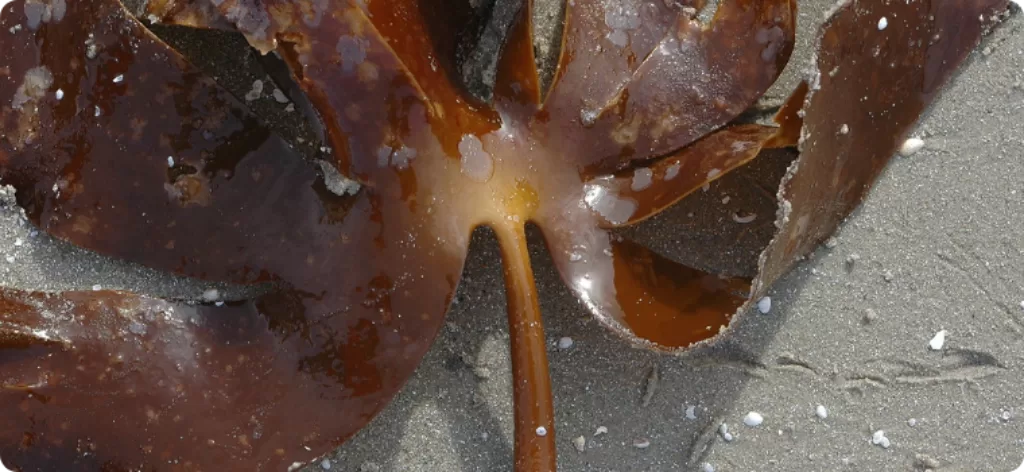Laminaria hyperborea (Tangle / Cuvie)

Characteristics
Laminaria hyperborea is a type of large brown algae of the family Laminariaceae. It grows in both exposed and sheltered sublittoral zones (fairly shallow coastal areas where sunlight reaches the ocean floor) of the northern Atlantic Ocean.
This seaweed is distinguished by its blade-like fronds. Laminaria comes from the Latin lamina, meaning "blade," and refers to the blade-like-lashes of the seaweed. Hyperborea was the name for a mythical northern land in Greek mythology. Common names of this species include tangle, cuvie, redware, sea tangle, cuvy, sea rod, mayweed, and Slat mara.

The size and appearance of both blades and stipes of this species vary with exposure and current. In sheltered conditions, blades tend to have few or no digits and the stipe is thin. However in exposed conditions, the blades have multiple digits with thick stipes. The stipes of L. hyperborea average 1 meter in length, but stipes up to 3 meters in length have been recorded.
Geographical spread & harvest season in Europe
Laminaria hyperborea is found in cold North Atlantic and Arctic oceans. It grows naturally along most British and Irish coasts and in the North Sea, along the Scandinavian coasts. It is scarce along the eastern coasts of Britain, due to a lack of suitable substrata. Globally, it can be found in the north Atlantic from Iceland to the Russian coasts, and in the south Atlantic to mid-Portugal, including Norway, the Faroes, northern France, and northern Spain.

L. hyperborea is a perennial plant, and can live for up to 20 years. Adult plants grow rapidly until about 5 years old, with new blades appearing below the older growth from November onwards. Peak growth occurs during winter and stops in summer, initiated by a photoperiodic response to day length. The old blades are shed in spring and early summer. Its normal harvest season is April or May, extending through October.
Nutritional content
Laminaria hyperborea contains abundant vitamins, minerals, and trace elements. It contains iodine, an element that the body needs to make thyroid hormones, and is also a rich source of iron and potassium. Nutrients found in L. hyperborea include calcium, magnesium, carotene, protein, alginic acid, laminaran, mannitol, niacin, phosphorus, the B complex vitamins, and vitamin C.
Uses in food
Laminaria hyperborea is not as commonly used as a human food product as some other seaweeds. However, it is used as a food in many Asian countries – as a flavoring agent, a food additive, and as an edible vegetable. The leaves, when boiled for about 30 minutes, become tender and have a mild, potato-like taste. They can also be fried as bacon, like oarweed.
- Alginate, one of the substances extracted from L. hyperborea, is used in over 600 products. It is commonly used in ice creams, in various gels, and to lessen the symptoms of acid reflux.
- Sea tangle has also been used as an ingredient in the manufacture of meat products such as patties and breakfast sausages, to reduce cooking loss and provide a better texture.
- In recent years, L. hyperborea has been used to create brands of imitation caviar for vegetarians and vegans.

Uses other than food
The commercial value of a seaweed species can often be derived from the technique that is used when harvesting it. Most species of seaweed are harvested manually. Species that are harvested by boat and mechanical tools, such as Laminaria hyperborea, can be considered to have a higher potential value. These techniques have been developed by local industry in France or Norway, where harvesting is undertaken by boats, using a seaweed trawl, a paddle wheel cutter, or a vacuum-sucker.
- Traditionally, the greatest proportion ofLaminaria hyperborea commercial cultivation has been for algin, iodine, and mannitol, which are used in a wide range of industrial applications.
- L. hyperborea is often collected and used as an agricultural fertiliser and soil conditioner.
- L. hyperborea is commonly used as caprine (sheep and goats) feed in the UK. For example, in the Orkney Islands, L. hyperborea and similar species such Laminaria digitata and Saccharina latissima account for 90% of the summer feed of sheep. This has been found to meet a substantial amount of the sheep's nutrient requirements, because the seaweed contain up to 13% crude protein.
- In the field of medicine, L. hyperborea
has traditionally been used in wound dressings to prevent adhesion, and to dilate the cervix during childbirth. It is being investigated for many other uses because of its unique ability to absorb and retain water.
Biological Traits Information Catalogue, "BIOTIC Species Information for Laminaria hyperborea" Accessed 16 April 2021. http://www.marlin.ac.uk/biotic/browse.php?sp=4192
Groenendijk, F., et al. "North-Sea-Weed-Chain: Sustainable seaweed from the North Sea; an exploration of the value chain" IMARES Report number C055/16. May 2016. https://edepot.wur.nl/386907
AlgaeBase. "Laminaria hyperborea (Gunnerus) Foslie 1885" AlgaeBase. Accessed 16 April 2021. https://www.algaebase.org/search/species/detail/?species_id=27
WebMD. "Laminaria" Accessed 16 April 2021. https://www.webmd.com/vitamins/ai/ingredientmono-542/laminaria
Cain, J. "Synopsis of Biological Data on Laminaria hyperborea" http://www.fao.org/3/c3845e/c3845e.pdf
The Seaweed Site: information on marine algae. "Laminaria hyperborea (Gunnerus) Foslie" Accessed 16 April 2021. https://www.seaweed.ie/descriptions/Laminaria_hyperborea.php
MarLIN. "Tangle or cuvie (Laminaria hyperborean)" The Marine Life Information Network. https://www.marlin.ac.uk/species/detail/1309
Vea. J., Ask, E. I., "Creating a sustainable commercial harvest of Laminaria hyperborean, in Norway" Journal of Applied Phycology 23(3):489-494, June 2011. https://www.researchgate.net/publication/225735798_Creating_a_sustainable_commercial_harvest_of_Laminaria_hyperborea_in_Norway
Drugs.com. "Laminaria" Accessed 16 April 2021. https://www.drugs.com/npp/laminaria.html